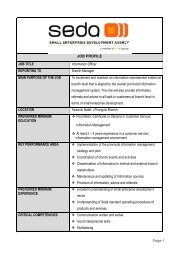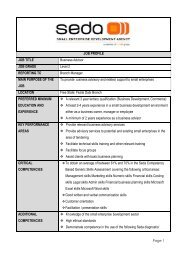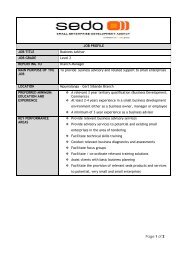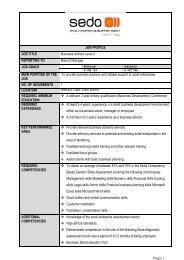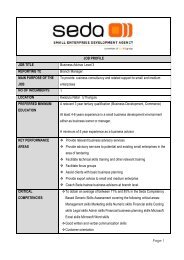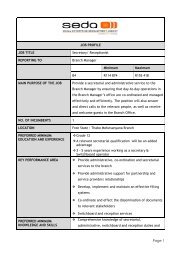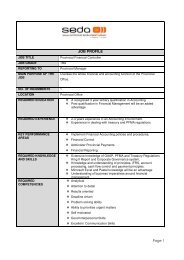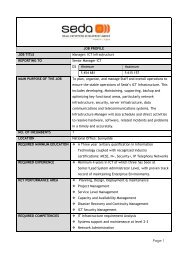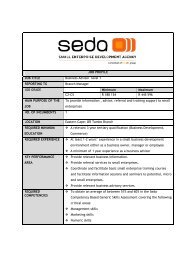Assessment of Cooperatives in the Poultry Industry - 2013.pdf - Seda
Assessment of Cooperatives in the Poultry Industry - 2013.pdf - Seda
Assessment of Cooperatives in the Poultry Industry - 2013.pdf - Seda
Create successful ePaper yourself
Turn your PDF publications into a flip-book with our unique Google optimized e-Paper software.
Research Report: Address<strong>in</strong>g <strong>the</strong> Needs, Opportunities and Challenges <strong>of</strong> <strong>Cooperatives</strong><br />
and Collectively Owned Enterprises <strong>in</strong> <strong>the</strong> <strong>Poultry</strong> and Related Industries<br />
Accord<strong>in</strong>g to a report on <strong>the</strong> broiler <strong>in</strong>dustry supply cha<strong>in</strong> (Louw: 2011), various issues are<br />
highlighted by growers, which <strong>the</strong>y experienced as immediate challenges to <strong>the</strong> poultry <strong>in</strong>dustry.<br />
These <strong>in</strong>clude <strong>the</strong> follow<strong>in</strong>g:<br />
<br />
<br />
<br />
quality and consistency <strong>of</strong> feed and associated raw components<br />
changes <strong>in</strong> technology and <strong>in</strong>novation<br />
electricity supply, price and availability<br />
<strong>in</strong>put prices o<strong>the</strong>r than <strong>the</strong> cost <strong>of</strong> feed (e.g. <strong>in</strong>terest rates, labour, runn<strong>in</strong>g costs )<br />
<br />
<br />
<br />
<br />
<br />
market degradation <strong>of</strong> poultry markets<br />
transport and road <strong>in</strong>frastructure<br />
disease and <strong>the</strong> control and conta<strong>in</strong>ment <strong>of</strong> outbreaks<br />
imports and <strong>the</strong> <strong>in</strong>ability to control <strong>the</strong> dump<strong>in</strong>g <strong>of</strong> poultry products <strong>in</strong> South Africa<br />
skills levels <strong>of</strong> management and <strong>the</strong> team, and <strong>the</strong> farm structure.<br />
In order to understand <strong>the</strong> challenges fac<strong>in</strong>g develop<strong>in</strong>g farmers, this holistic picture is vital. While<br />
cooperatives are able to identify <strong>the</strong> <strong>in</strong>sufficiencies with<strong>in</strong> <strong>the</strong>ir own bus<strong>in</strong>ess, <strong>the</strong> large picture<br />
enables greater forward plann<strong>in</strong>g. Additionally, <strong>in</strong> provid<strong>in</strong>g advice to develop<strong>in</strong>g farmers, feedback<br />
on <strong>the</strong>ir own bus<strong>in</strong>ess activities alone is not sufficient. A comprehensive understand<strong>in</strong>g <strong>of</strong> <strong>the</strong><br />
challenges <strong>of</strong> <strong>the</strong> <strong>in</strong>dustry enables <strong>the</strong> ability to harness positive aspects and ensure that bus<strong>in</strong>esses<br />
are shielded from potential market threats.<br />
Based on <strong>the</strong> report (Louw: 2011), <strong>the</strong> follow<strong>in</strong>g issues and challenges were ranked highly by broiler<br />
hold<strong>in</strong>g companies as concerns and challenges that <strong>the</strong>y face <strong>in</strong> <strong>the</strong> poultry <strong>in</strong>dustry:<br />
<br />
<br />
<br />
<br />
<br />
<br />
<br />
<br />
manag<strong>in</strong>g <strong>the</strong> price volatility <strong>of</strong> <strong>in</strong>puts<br />
imports <strong>of</strong> poultry meat<br />
manag<strong>in</strong>g pr<strong>of</strong>itability <strong>in</strong> this dynamic <strong>in</strong>dustry<br />
exchange rate volatility<br />
availability <strong>of</strong> good genetic material and parent stocks<br />
governance structures<br />
manag<strong>in</strong>g waste material and environment impact studies<br />
<strong>in</strong>frastructure<br />
The Department <strong>of</strong> Agriculture organised a National Agricultural <strong>Cooperatives</strong> Indaba <strong>in</strong> 2012, to<br />
which various stakeholders were <strong>in</strong>vited. At <strong>the</strong> <strong>in</strong>daba various issues affect<strong>in</strong>g cooperatives and<br />
smallholder farmers were discussed. It was agreed that smallholder farmer’s cooperatives <strong>in</strong> South<br />
Africa do not have a great deal <strong>of</strong> negotiat<strong>in</strong>g power due to a number <strong>of</strong> reasons <strong>in</strong>clud<strong>in</strong>g:<br />
<br />
<br />
<br />
<br />
<br />
<strong>the</strong> quantum and value <strong>of</strong> assets that <strong>the</strong>y possess<br />
<strong>the</strong>ir carry<strong>in</strong>g capacity – both f<strong>in</strong>ancial and <strong>in</strong>frastructural<br />
volume <strong>of</strong> operations<br />
lack <strong>of</strong> market <strong>in</strong>formation<br />
lack <strong>of</strong> access to formal f<strong>in</strong>anc<strong>in</strong>g mechanisms <strong>in</strong> <strong>the</strong> absence <strong>of</strong> collateral<br />
66 | P a g e U r b a n - E c o n : D e v e l o p m e n t E c o n o m i s t s



